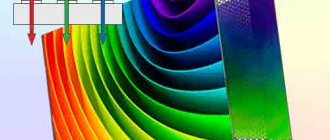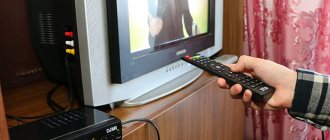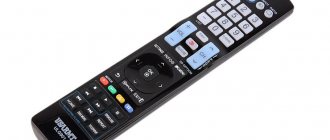LCD TVs have firmly taken their place in our homes. It is unlikely that anyone would think of buying CRT or tube equipment, except perhaps for lovers of rarities and collectors. Moreover, the cost of the latter is no longer calculated by practicality, but rather by museum value.
Today's market offers a huge number of types, types and specific models of LCD TVs. And it’s very easy to get confused in all this diversity, especially for the average consumer. When choosing such a technique, many factors need to be taken into account. This includes the service life of the LCD TV, the diagonal, the matrix, the backlight and much more. So you need to approach the purchase intelligently and seriously. But first things first.
From our article you will learn what LCD TVs can be found on sale, what to look for when choosing equipment of this kind, and how not to make a mistake with the purchase. We will take into account the advice of experts in this field and consumer reviews. So let's get started.
What is an LCD screen?
Before we tell you what kind of LCD TVs there are, let’s first understand the technology itself. If we omit all the technological aspects that will be of interest only to engineers, then we can say that the LCD panel is a sandwich.
The main structural elements of such a TV are two electronic boards. Between them passes a kind of liquid, where small granules - crystals - are located. The latter play the role of pixels - points on the screen from which the whole picture is formed.
But the crystals themselves do not glow, so this part of the work falls on the shoulders of LEDs placed at the ends or behind the panel. It is also worth noting that they emit only white light, which is colored using RGB filters. There is at least one of these in front of each crystal, but there is.
This technology is called LED. Previous generation LCD TVs were powered by LCD backlighting, where the main ones were small fluorescent lamps and one large cold cathode lamp. This technology did not allow for uniform dimming of the screen, and the use of LEDs solved this problem.
So all modern digital LCD TVs come with LED backlighting. You can also find LCD models on sale, and they have their advantages, but experts in this field still recommend choosing a more modern technology. So at this point (LED/LCD) you need to pay special attention when choosing TV equipment.
Next, let’s look at how LCD TVs with LED backlight differ from each other.
Matrix
The matrix is the main element of the TV, responsible for the picture quality. In stores you can find a lot of its varieties, but only four types stand out among others. Other output image parameters, as well as the ability to fine-tune the LCD TV, depend on the type of matrix. Let's take a closer look at each type.
One of the main advantages of IPS matrices is the widest viewing angle available today, that is, 178 degrees. If the user is within this angle, the image will be clear and not blurry.
The black color of IPS matrices is deep and looks almost perfect. Perhaps the only significant drawback of this type is the response time. IPS in this case is slightly inferior to other matrices. The problem was partly solved by modifying the S-IPS, but at the same time the service life of the LCD TV became slightly shorter.
This technology is the most widespread and accessible. There are a lot of reviews about her, most of them are written in a positive way. IPS matrices simply do not have any serious disadvantages.
This is a proprietary development, which is a close analogue of an IPS matrix. The performance qualities remained almost the same, with the only difference being that the brand managed to significantly reduce production costs, as well as the cost of the TVs themselves.
This type of matrix has many modifications. The first generation of VA had one significant drawback: when the viewing angle changed, the colors on the screen began to “dance,” although the clarity and detail remained the same.
The problem was solved with the help of a modern modification of S-PVA. The latter has been adopted and is actively used by the Sony brands in their Bravia and LG and Samsung. Here, dynamic scenes are displayed as expected and the response time is significantly reduced. The only thing where VA IPS is inferior is in the processing of halftones. This is especially noticeable if you connect both types of LCD TVs in a dark room.
Reviews of VA technology are mostly positive. The latest generation matrices made on it are good in many ways, but the only fly in the ointment is the viewing angles. Whatever one may say, IPS has more of them. Another advantage of VA that cannot be discounted is its low cost.
Direct LED
This type of backlight is also called direct. Here we have a uniform arrangement of crystals throughout the panel. Between the screen itself and the light source there must be a special flux diffuser.
This technology requires the presence of space between each element. They should not be located closely, otherwise a complete picture will not work. The thickness of models with Direct Ice technology is noticeably greater than that of Edge Ice, but at the same time the image quality is clearly better. This is confirmed not only by experts, but also by numerous reviews of LCD TVs with Direct LED.
How to extend the trouble-free life of your TV
Following some simple rules will help extend the life of your TV. Like all household appliances, this device requires careful handling and care. Even if it is not possible to increase the service time for a long time, the equipment will function better.
- The device has ventilation holes that must be systematically cleaned of dust. To do this, you can purchase special wipes for computers and household appliances.
- Do not allow dust to accumulate on the screen; wipe it regularly.
- It is not recommended to watch TV programs in high brightness and image clarity mode. The maximum values of technical parameters carry a large load, especially for LCD and plasma platforms.
- Automatic power saving function helps you control screen brightness.
- Many models have a shutdown timer. If you don't always remember to turn off the TV at the end of a program, you can use this function.
Important! The optimal TV setting gives a high-quality image and a clear, bright picture as a whole. Overestimating or underestimating the parameters of brightness, clarity, or too saturated color will shorten the service life of the equipment.
Televisions of the same type, but from different manufacturers, have different operating times. The above timeframes are subject to change as manufacturers continually adopt new technologies in an effort to improve their products. This must be remembered when purchasing this device. You can increase the service life by using the equipment carefully. Then your expensive purchase will delight you for many years.
Published:09.21.2019
Nowadays, there are various types of televisions. Almost all manufacturers began to indicate the service life of the TV on each of their released models. This parameter began to cause concern not only among users, who began to wonder how long will my TV last? But also for potential buyers who want to purchase a high-quality model, so that in a couple of years they will not have to buy a new TV again. Different types of TVs have different lifespans. But the service life does not mean the time that the TV will work. After the end of the stated service life, your TV will continue to work. Such is the confusion. We will examine in detail the issue regarding the service life of the TV so that you do not have any questions. Read more - What does the manufacturer’s stated service life of a TV mean?
Join the group and you will be able to view images in full size
Add to favoritesComplain Comments
Do you think that the service life of the TV specified in the operating instructions is a verdict from the manufacturer? You are wrong!
Edge LED
This type of backlight is called edge lighting. In this case, all the LEDs are located on the side edges of the screen. One of the main features of this design is the significant savings in internal space. Thanks to this, the thickness of TVs with Edge Ice is much thinner than that of Direct Ice.
But this technology also has its obvious disadvantages. The biggest problem is the presence of “flares” or uneven lighting. If the side bars are even slightly deformed, then problems cannot be avoided. For this reason, experts strongly advise against purchasing Edge Ice models with inclined or suspended installation.
In this case, the thin body is especially susceptible to deformation. This does not threaten most premium models due to the abundance of metal elements, but with devices from the mid-price and budget segment you need to be more careful and attentive.
IPS
One of the main advantages of IPS matrices is the widest viewing angle available today, that is, 178 degrees. If the user is within this angle, the image will be clear and not blurry.
The black color of IPS matrices is deep and looks almost perfect. Perhaps the only significant drawback of this type is the response time. IPS in this case is slightly inferior to other matrices. The problem was partly solved by modifying the S-IPS, but at the same time the service life of the LCD TV became slightly shorter.
This technology is the most widespread and accessible. There are a lot of reviews about her, most of them are written in a positive way. IPS matrices simply do not have any serious disadvantages.
Operating period depending on manufacturer
Most of the TVs available on the market are represented by 4 companies:
- Samsung (Samsung).
- LG.
- Sony (Sony).
- Philips (Philips).
These brands have long established themselves as reliable manufacturers that produce truly high-quality products. The service life of their devices, regardless of the model and type of screen, is almost the same.
| Brand | Samsung | LG | Sony | Philips |
| Lifetime | 5 years | 5 years | 7 years | 5 years |
V.A.
This type of matrix has many modifications. The first generation of VA had one significant drawback: when the viewing angle changed, the colors on the screen began to “dance,” although the clarity and detail remained the same.
The problem was solved with the help of a modern modification of S-PVA. The latter has been adopted and is actively used by the Sony brands in their Bravia and LG and Samsung. Here, dynamic scenes are displayed as expected and the response time is significantly reduced. The only thing where VA IPS is inferior is in the processing of halftones. This is especially noticeable if you connect both types of LCD TVs in a dark room.
Reviews of VA technology are mostly positive. The latest generation matrices made on it are good in many ways, but the only fly in the ointment is the viewing angles. Whatever one may say, IPS has more of them. Another advantage of VA that cannot be discounted is its low cost.
What technical problems may occur and their symptoms?
However, violation of established operating rules often leads to the following problems:
- matrix malfunction (no image);
- burning of the control chip (lack of color);
- burnout of the ULF path microcircuit (no sound);
- failure of the IR receiver (the buttons on the remote control do not switch);
- Tuner failure (failure of auto-tuning channels).
So, according to the manufacturers’ recommendations, 6 hours is exactly the period for how long you can leave the TV on. Violation of this mode may lead to malfunctions.
Source: tehznatok.com
The New Year holidays are approaching and, undoubtedly, people will spend much more time in front of the TV. This electrical appliance, like any other, is a source of increased danger. This means that the issue of its operation must be approached extremely carefully. We have collected 6 main rules for handling TV.
1. No water
The TV should be protected from possible “water procedures”. Some people like to use the device as a shelf for a vase of flowers. This is strictly prohibited! One awkward movement, and the vase can tip over and water can get inside the device. This will lead to a short circuit and damage the equipment.
2. The main thing is support
The TV should be on a stable base, be it a bedside table or a sectional niche. This requirement is especially important if there is a small child in the family - he can knock over the device at any minute. If you place the TV in a niche of a furniture set, make sure that the distance recommended by the manufacturers is maintained from the device to the walls - this is necessary for normal ventilation of the equipment.
3. Do not turn it on in cold weather
When bringing the TV from the cold into a warm room, it must be allowed to warm up to room temperature. It is believed that sudden temperature changes can lead to equipment failure. But it is not so. The fact is that in the cold the TV cools down. And when it gets into a warm room, condensation forms on it, according to all the laws of physics. And if the TV is turned on immediately, water droplets can cause a short circuit.
4. The closer to the outlet, the better
The TV should be installed near an outlet, and cords and extension cords should be hidden in special covers or furniture panels - they should not stretch across the entire room. This is important if you have a baby - he should not touch the wires and especially the outlet to which they lead. In addition, it is inconvenient because you will constantly stumble over them.
5. When leaving, turn off
The TV should not be left on unattended, even if you want to leave for a few minutes. The point is not about saving energy, although this point should not be discounted. It’s just that in this case the principle of “God saves the best” works: if the device suddenly closes, you must be nearby to take action in time. Unfortunately, crime reports regularly contain information about fires caused by a TV short circuit. And, worst of all, this often leads to human casualties.
6. Extinguish with a blanket
If the TV sparkles or, even worse, catches fire, under no circumstances should you extinguish it with water - this can lead to an explosion of the picture tube. First of all, the device should be disconnected from the electrical network - unplug the cord from the outlet or turn off the power to the entire apartment. Next, you will need a blanket or an old coat - it should be thrown over the TV to block the access of oxygen to the fire. Instead of a blanket, you can use regular washing powder or even soil from a flower pot. After the problem has been fixed, it is necessary to immediately ventilate the room - during combustion or melting, toxic substances are released that can lead to poisoning.
Permission
The clarity of the image depends on the resolution of the matrix. The more dots the screen can display, the more detailed the picture will be. The SD format with a layout of 640 by 480 pixels has long been a thing of the past. It has been replaced by new generations, which can be seen on store shelves.
Current layout of modern TVs:
- HD – 1366 by 768 pixels.
- Full HD – 1920 by 1080.
- UHD/4K – 3840 by 2160.
This parameter is fully revealed when watching digital television and individual video content. But you shouldn’t expect any significant changes during the broadcast of analogue air, because it is already in a predetermined layout.
The most common resolution today is Full HD. Most manufacturers of both TVs and content are targeting this format. Yes, 4K films are being added every day, but there are still too few of them for the mass consumer.
Can a TV last 10 years?
According to a study conducted in 2021 by the Federal Office for the Environment, the televisions of 50% of respondents did not live to see their tenth anniversary: half of them broke or had some kind of defect. However, most TVs continue to work after this period.
Typically the manufacturer's warranty is 2 years, which means that the TV will function for at least this time. If the device lasts longer, the warranty will not cover all “excesses”. An expensive TV will not necessarily last longer than a cheap model. Even budget TVs will be able to delight you with your favorite programs for more than 10 years. Some manufacturers even extend the warranty until this period, although such models usually cost more.
Diagonal
Some people mistakenly believe that this parameter is the main one when choosing a TV, but in reality it’s not that simple. The diagonal of the LCD TV must be selected taking into account the size of the room where it will be located. For example, in a small bedroom it will be very difficult to enjoy all the benefits of a massive LED panel, because the user simply will not be able to take in the entire image at one glance - he will have to turn his head from side to side so as not to miss an important moment on the screen.
Judging by the reviews of the owners, for modest-sized rooms like a kitchen or even a bedroom, the best option would be a diagonal of 19 to 26 inches. If the rooms are large, then you can take a closer look at 32” devices. In general, a diagonal of 32-49 inches is a universal option for living rooms and other large rooms.
If we are talking about organizing a home theater, then it is worth considering models from 50 to 64”. Devices with a larger diagonal can be found in commercial establishments, because such dimensions imply decent room dimensions.
What devices do not need to be turned off?
According to the expert, modern equipment, designed for use around the clock, is made in such a way that it does not need to be unplugged. We are talking about a refrigerator, router, air conditioner and similar devices. “Engineers make these devices on the assumption that they will operate continuously. Then these products are tested, then put on the market, they receive reviews. Of course, the manufacturer tries to ensure that there is no deviation from the declared characteristics. But failures can occur in any technology. Even if it’s a one in 100 million case,” says von Meck.
To understand whether the device is suitable for permanent use or not, you need to read the instructions before using it. “You need to refer to the instructions, they contain the rules for safe use. Each device has its own: some need to be turned off after use, others do not. It is also important that the device has a safety certificate. It should be noted in the passport or somewhere on the packaging or on the device itself that it complies with GOST - this means that it is certified. This technique shouldn’t be scary,” says the specialist.
Sound
When choosing an LCD model, many people overlook such an important parameter as sound. Even if the model produces an amazing picture, all the positive emotions will go down the drain due to the mediocre sound.
Here it is worth immediately noting that due to the design features of LCD TVs, they, in principle, cannot accept professional acoustics on board. So in most cases you will have to take care of an independent system. Nevertheless, many manufacturers are trying to maintain, if not professional, then at least simply a high level of acoustics.
For example, it equips its models with technically advanced Long DuctSpeakers, which have a spiral shape. They don’t take up much space, but despite their modest size, they produce quite adequate sound – clear and powerful. Naturally, you can’t count on exceptional low frequencies with such “babies,” but movies, videos and other content that excludes the heavy metal genre are quite comfortable to watch.
Some manufacturers include some innovative software in the TV's firmware that allows it to process and produce good sound even on mediocre speakers. Among others, we can note such systems as ClearAudio, Bass Reflex, Clear Phase, etc.
Interfaces
When purchasing an LCD TV, it is clearly worth paying attention to the quantity and quality of interfaces. The list of connected peripherals directly depends on them. Experts strongly recommend checking the availability of a USB interface and an HDMI output.
The first is necessary for working with external drives, as well as viewing third-party content, and the second is a universal port for most modern peripheral equipment. The latter include media devices, game consoles and various types of players. All of them are necessarily equipped with an HDMI interface.
What does this time period depend on?
Buyers usually pay attention to broadcast quality, sound and picture clarity. However, service life largely depends on the following parameters:
- specific model;
- matrix parameters;
- screen type;
- characteristics of the video processor and other components;
- the ability to individually customize the image;
- operating conditions of the device and its care;
- duration and frequency of watching television programs.
During the purchasing process, it is recommended to compare the parameters of several similar models and choose the most optimal option.
In addition, it is worth choosing a reliable brand, as these companies try to ensure a long service life of the TV.
If you follow preventive measures and rules of use, the service life of various equipment can be several decades! From our materials you will learn what the service life is and what affects the service life of LED lamps, refrigerators, gas stoves, smartphones, polypropylene pipes, washing machines, cars, as well as how to determine the shelf life of panel and other houses.
Life time
It is worth immediately warning about some legal aspects of this parameter. If the instructions do not indicate the service life of the LCD TV, then by default it is 10 years. This is spelled out in black and white in the Durable Goods Consumer Protection Act.
The fact is that manufacturers deliberately underestimate the service life of such equipment in order to simply not maintain it. This approach is justified by the inexpediency of repairs. The cost of the latter is almost equal to a new device.
On average, LCD TVs with LED panels last about 30,000 hours (continuous operation). If we take into account the reviews of owners of such equipment, the device lasts about five years. If the model is premium, then for 7 years or more.
In this case, plasma technology significantly outperforms LCD, where panels last 100,000 hours. But there are pitfalls here too. The fact is that plasma TVs are 3 or even 4 times more energy-hungry than LCD TVs. In addition, the screen resolution of “plasma” is lower, which means the clarity and detail are at a low level. So this is a double-edged sword - you have to sacrifice something.
How long does the average TV last?
In relation to a TV, like any other household appliance, two concepts should be used and distinguished - “service life” and “warranty period”. The warranty period is a period determined by the manufacturer during which failed TV parts can be replaced free of charge with serviceable ones or repaired. The duration of this period ranges from one to two years.
The service life of any device cannot be defined in a time frame. Its completion cannot be indicated by any specific date. The service life of a TV is directly related to the brightness of the picture broadcast and its quality. For example, with a set duration of use of 50,000 hours, it does not mean that after their expiration the device can be safely thrown into the trash. It will continue to work, but the color rendition of the picture on its screen will be partially distorted, which means it will be perceived completely differently. The situation is the same with the functional part - it will not stop performing all functions, but it will do it with less quality.
The service life of a regular, non-sophisticated TV model is extremely difficult to predict. Some models may, after working for a couple of decades, continue to work without causing any particular complaints from the owners, while others may not last even five years.











